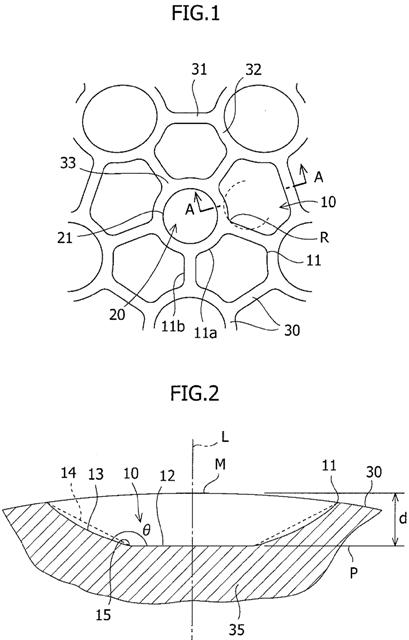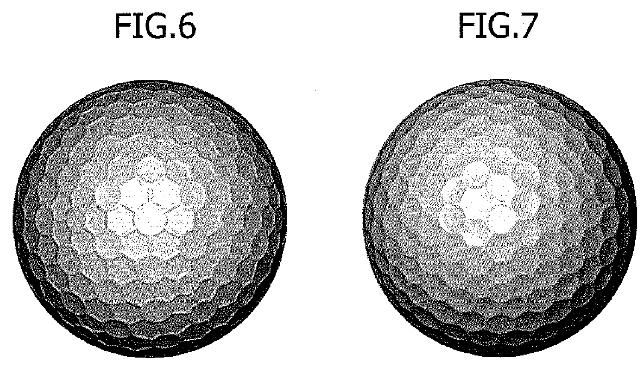Check out this Bridgestone Dimple Design
Last month I posted about an Acushnet golf ball dimple patent application that was eye catching. Today, a Bridgestone patent application published disclosing an equally interesting dimple design. The application published as US Pub. No. 20100093468 titled “Golf Ball,” which describes the invention as:
BACKGROUND OF THE INVENTION
[0001] The present invention relates to a golf ball and, more particularly, relates to a golf ball having dimples formed on the surface thereof to improve the carry.
[0002] In designing a golf ball, it is well known that to obtain a long carry when the golf ball is hit, a high coefficient of restitution inherent in the golf ball itself and low air resistance in the flight time caused by dimples arranged on the surface of golf ball are important. Usually, many dimples are arranged on the surface of a golf ball. To reduce the air resistance, there have been proposed various methods for arranging the dimples on the surface of golf ball at a density that is as high as possible and uniformly.
[0003] Japanese Patent Application Publication No. 2006-095281 and Japanese Patent Application Publication No. 2008-12299 describe that by arranging noncircular dimples between circular dimples, the surface occupancy ratio of dimples is increased to improve the aerodynamic performance of a golf ball. Also, Japanese Patent Application Publication No. 2007-21203 describes that the wall surface of a dimple is formed by a plurality of flat surfaces to improve the carry of a ball that has been hit.
[0004] However, the shape of the bottom surface of the noncircular dimple described in Japanese Patent Application Publication No. 2006-095281 and Japanese Patent Application Publication No. 2008-12299 is curved so as to deepen toward the center of the dimple. Therefore, although the surface occupancy ratio of dimples can be increased, there is a tendency for the depth of the dimples to increase. For such a shape, since the surface occupancy ratio of dimples is high, the air resistance during flight decreases. However, the lift of the golf ball is excessive in a high-speed region after the ball has been hit, so that there is a tendency for the golf ball to be blown upward, and there is also a tendency for the lift of golf ball to not continue for long in a low-speed region in the latter half of the trajectory. Therefore, a sufficient carry cannot be obtained.
SUMMARY OF THE INVENTION
[0005] Accordingly, an object of the present invention is to provide a golf ball configured so that even if the surface occupancy ratio of dimples is increased, the depth of the dimple is kept shallow so as to restrain a lift acting on the golf ball flying in a high-speed region after the ball has been hit, and the lift of the golf ball flying in a low-speed region in the latter half of trajectory is maintained for longer, by which a longer carry can be obtained.
[0006] To achieve the above object, the present invention provides a golf ball comprising a plurality of dimples formed on the surface thereof, in which at least about 10% of the dimples among the total dimples on the surface are noncircular dimples in which a boundary line between a land part and the dimple comprises a curved line part and a straight line part, and the noncircular dimples each have a flat bottom surface.
[0007] The bottom surface of the noncircular dimple may preferably have a circular or polygonal planar shape. Also, the bottom surface of the noncircular dimple more preferably may have a planar shape approximately similar to the boundary line. In order for the distance between the bottom surface and the boundary line to be capable of being kept constant, the curved line part and the straight line part in the boundary line of the noncircular dimple may be connected to each other with a part having a smooth curvature.
[0008] The surface occupancy ratio of the noncircular dimples to the surface of the golf ball preferably may be at least about 65%. Also, at least about fifty noncircular dimples preferably may be formed. For the golf ball in accordance with the present invention, the lift coefficient CL at Re 70000/2000 rpm preferably may be at least about 70% of the lift coefficient CL at Re 80000/2000 rpm, and the drag coefficient CD at Re 180000/2520 rpm preferably may be up to about 0.225.
[0009] Thus, according to the present invention, at least about 10% of the dimples among the total dimples formed on the golf ball are made noncircular dimples in which a boundary line between a land part and the dimple comprises a curved line part and a straight line part, and the bottom surfaces of the noncircular dimples are made flat. Thereby, the dimples are formed so as to be shallow. Therefore, even if the surface occupancy ratio of dimples is high, a proper total volume of dimples can be maintained. Thereby, a lift that is acting on the golf ball flying in a high-speed region after the ball has been hit is restrained, and blowing upward can be prevented. Also, the lift of the golf ball flying in a low-speed region in the latter half of trajectory is maintained for longer, and the flight duration can be increased, by which the carry can be improved.



Cool stuff!
David Dawsey – Keeping an Eye on Golf Ball Inventions
PS – check out THIS recent post in which I questioned whether the traditional dimple has reached the end of its useful life.
PPS – click HERE to read more interesting golf ball patent posts
